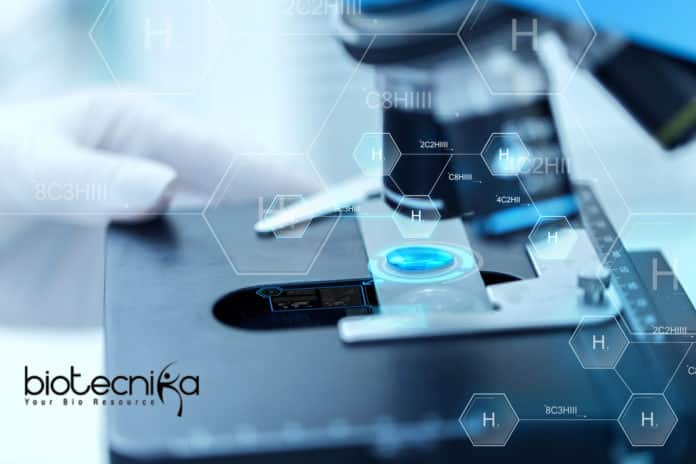Smartphone Converted into Fluorescence Microscope
Researchers from the U.S. and China have developed a method to transform a smartphone into a fluorescence microscope. It is called as the handheld smartphone-fluorescence microscope (HSFM). This device allows complex biomedical analyses both rapidly and is cost-effective.
The Conventional fluorescence microscopes play an essential role to detect different cells and proteins, but they are bulky and inconvenient for point-of-care diagnoses.
Bo Dai and a team of interdisciplinary research scientists made the use of liquid polymers to create mini two-droplet lenses dyed with colored solvents. The lenses are compatible across different smartphone devices. The low-cost, equipment allowed them to observe and count cells, monitor the expression of fluorescently tagged genes, and distinguish between healthy tissues and tumors.
What is Fluorescence Microscopy?
Fluorescence microscopy is a crucial technique in multiple disciplines of Life Sciences. These include cell and molecular biology, environmental monitoring, the healthcare industry. In biomedicine and clinical applications, fluorescent imaging techniques can detect and track cells, proteins, and other molecules of interest with very high sensitivity and precision
. Portable microscopes are an essential development on an ideal smartphone platform for mobility and accessibility to a range of users.The fundamental problem faced by the researches is due to the various models of smartphones currently available in the market for users. Scientists aim to develop an attachment for smartphone-based microscopy whose design is independent of a specific phone model.
To address this challenge, Dai and team, the team of researchers, developed a low-cost handheld smartphone fluorescence microscope- (HFSM) in a portable size. The HRSM uses a single compact and multifunctional color lens to convert any smartphone model into a fluorescence microscope. This is done without modifying the attachment design between phones. This experiment was designed to reduced the HRFM device complexity and allowed its adoption across a variety of smartphones. The research team used the tool to demonstrate bright field and fluorescent imaging in various bioanalytical applications within cells, including the tissues.
For the HFSM module, Dai and team included a color compound lens for imaging as well as light filtering. They developed a mini lens using two high refractive-index (RI) droplets. One of them inside another dyed with colored solvents to transmit the desired emission light to the imaging sensor. During the cell counting experiments, Dai and co-workers clearly distinguished the individual cells and calculated the cell concentration. This agreed accurately with the results obtained from a commercial cell counter to validate the HSFM device.
Scientists incubated human liver tissues with fluorescently tagged antibodies to detect regular or defective features of the tissue using the low-cost handheld smartphone fluorescence microscope- (HFSM) equipped with a green lens. Using the smartphone microscope, researchers accurately identified images of healthy tissues, para-tumor tissues, and cancerous tissues. For example, a higher expression of bright green fluorescence confirmed the presence of abnormal, diseased tissue.
The team of researchers then used the HSFM with a green lens to monitor transfection and the expression of enhanced green fluorescent protein within a plasmid. They transfected the GFP tagged human NLRP3 gene into a 293T human embryonic kidney cell line. After this, the researchers excited the transfected cells with a 480 nm blue light for bright green fluorescence emission. The excitation light filtered through the green lens for fluorescence emission, which Dai et al. captured as green spots using the smartphone. The results correlated well for both lens models (model I and II) relative to values measured using a conventional Fluorescence Microscope.
Dai and team subsequently used the setup to quantify superoxide production; a physiological marker of cardiovascular and neurodegenerative disease. For this, they stained an HBEC3-KT human bronchial epithelial cell line with MitoSox Red, a fluorogenic probe that can highly selectively detect superoxide, which they produced by interacting HBEC3-KT cells with lipopolysaccharides (LPS) in this work. The team observed a consistent increase in the mean fluorescence intensity of MitoSox Red to support the enhanced production of superoxide after LPS triggering.
Smartphone Converted into Fluorescence Microscope- Advantages of this Equipment
Bo Dai and co-workers provided a compact, affordable platform for fluorescence microscopy using a lens-based smartphone.
The setup captured images at cellular resolution and a field of view (FOV) on a tissue-wide scale. The capabilities relied on the pixel and image sensor size within the smartphone; a technology which continues to evolve.
The research team was inspired by preceding research work on a smartphone lens named the DOTlens developed elsewhere. The work presented here can serve as next-generation multifunctional lens modules for field-portable smartphone microscopes. Dai et al. believe the observed applications are merely the tip of the iceberg with more potential for future requests with the HSFM device.
They expect to develop the color compound lenses for additional fluorescent channels to enhance the capabilities of the cost-effective microscope significantly. The scientists envision the mass manufacture of low-cost, simple HFSM devices for mobile and customized healthcare applications at the point of care.






























